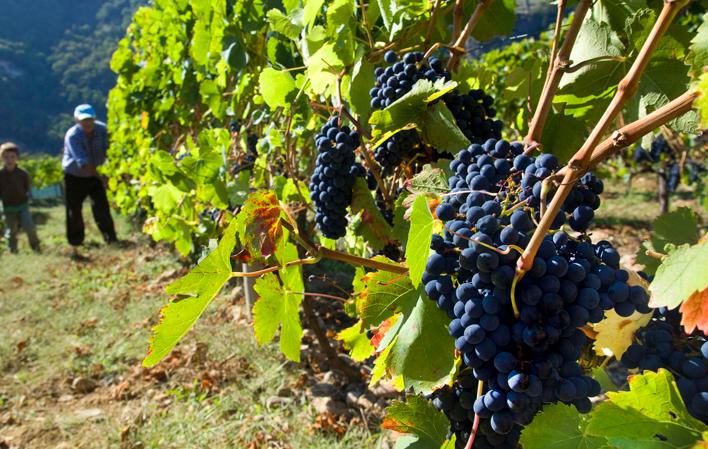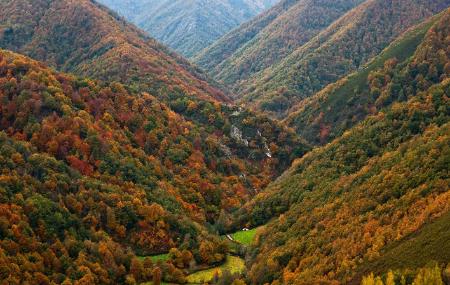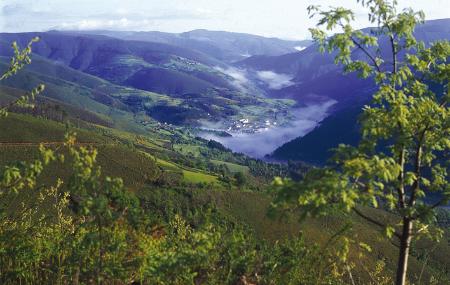
- Address Cangas de Narcea, Degaña e Ibias Western Asturias
- Distance Distance: 139,3 kms
- Difficulty Difficulty: Short
- Cars Cars: 5 days
- Start point Start point: Cangas de Narcea
- Route type Route type: car
The southwest of Asturias is a truly unique territory that never ceases to surprise locals and foreigners alike. In addition to the lushness of its valleys and the friendly outlines of its mountains, the helpful and welcoming nature of its people is an essential added value. And if we had to highlight some iconic features of the Fuentes del Narcea, Degaña and Ibias Natural Park - which is also a Biosphere Reserve - these would be viticulture, mining and its forests (including the Munieḷḷos Nature Reserve). So here we begin our 5-day journey through Cangas del Narcea, Degaña and Ibias.
Info
The southwest of Asturias is a truly unique territory that never ceases to surprise locals and foreigners alike. In addition to the lushness of its valleys and the friendly outlines of its mountains, the helpful and welcoming nature of its people is an essential added value. And if we had to highlight some iconic features of the Fuentes del Narcea, Degaña and Ibias Natural Park - which is also a Biosphere Reserve - these would be viticulture, mining and its forests (including the Munieḷḷos Nature Reserve). So here we begin our 5-day journey through Cangas del Narcea, Degaña and Ibias.
Route
Cangas del Narcea - Cangas del Narcea 0
Day 1: Cangas del Narcea, the capital of the council
Cangas del Narcea is the largest council in Asturias, and one of the largest in Spain. This large expanse of land, whose capital is called by the same name, is named after the Narcea River, which flows through its valley.
One of the must-see landmarks on your visit to this area is the capital of the council, Cangas del Narcea. Its intense history dates back to the Middle Ages, when Cangas was granted the Town Charter by Alfonso X, and you will see this as you stroll through the streets of its historic quarter. Many palaces come to meet you, with names that take you back to a past of medieval lordship, such as Omaña, Toreno, Peñalba or Pambley.
Don't miss the Basilica of Santa María, or the Wine Museum. And don't miss the Prau El Molín, where the famous "Descarga" (fireworks display) is held on the feast of Carmen, because in case you don't know, Cangas has had a great pyrotechnic tradition for over 100 years and the Society of Artisans of Cangas del Narcea performs an impressive display of voladores - a prayer in the form of gunpowder, as they call it - in honour of the Virgen del Carmen every 16th July.
In addition, and if you are a lover of river bathing, in the same Prau El Molín, there is a beautiful pool called La Presa, which takes advantage of the river water, and which is ideal for a comforting and safe bath.
There are many unique landmarks in the capital of Cangas del Narcea that await you: the Calle Mayor - always very atmospheric -, the Calle Arrastraculos, the Entrambasaguas neighbourhood - one of the oldest in the town - and where you will find the Carmen chapel, the Roman bridge, or the suspension bridge - over which you reach the Fuejo neighbourhood from the old quarter.
Cangas del Narcea: its viticulture, the Monastery of Courias and the Alto del Acebo 25,7
Day 2: Cangas del Narcea: its viticulture, the Monastery of Courias and the Alto del Acebo
Very close to the capital Cangas is the Monastery of Courias, today converted into a Parador Nacional, and whose church and library are well worth a visit. It also has an archaeological space explaining what the foundational monastery was like in the Middle Ages, and a spa that you can enjoy even if you are not staying there, subject to prior reservation.
Furthermore, the Courias Monastery is a notable historical and cultural landmark in the area, because the origin of vine cultivation in Cangas del Narcea began here, in the Middle Ages, at the hands of the monks, and of course, it was also an important centre of knowledge and teaching.
Gradually, viticulture became established in the southwest of Asturias, partly due to the favourable microclimate and partly thanks to the teachings of the monks.
Nowadays, the entire area around the capital and other lands in the council and neighbouring councils are full of vineyards, which have come to be called heroic, because some of them are literally hanging from the hillsides. In other words, they are high mountain vineyards growing in an abrupt and wild habitat.
Also, in the vicinity of the capital of Cangas, just over 9 kilometres away, is the Alto del Acebo with its sanctuary, one of the most important spiritual enclaves in the west and an exceptional natural viewpoint with a 360º view of the council of Cangas and the surrounding area. What's more, if cycling is your thing, you can always emulate your sporting prowess and do this pass from the town of Cangas.
Cangas del Narcea - Munieḷḷos - Mual 23,5
Day 3: Cangas del Narcea - Munieḷḷos - Mual
Just over 20 kilometres separate you from the Munieḷḷos Forest from the capital of the municipality. Munieḷḷos is the forest of forests, the great oak forest, one of the most remarkable in the Iberian Peninsula and one of the best preserved in Europe. There are 55 square kilometres of mountains, valleys, rivers and forests full of history and legend, which have remained practically untouched for almost 60 years.
Precisely because it is a Nature Reserve, which is also the habitat of the Cantabrian brown bear, access to Munieḷḷos requires prior permission, given that there is a quota of 20 visits per day, and it is ideal that you request yours as far in advance as possible. And if you get the chance to hike through them to the lagoons of La Candanosa peak, you're sure to have one of the most amazing hiking experiences of your life.
You will see that the route to Munieḷḷos puts in your way unique landmarks such as the medieval bridge of La Riela, or the beautiful village of Mual, which was named Exemplary Village of Asturias in 2018, and which is located right next to the forest of the same name, through which there is also an interesting hiking route.
In fact, Mual is the anteroom to Munieḷḷos, given that very close to this village is Las Tablizas, where the Munieḷḷos Forest Visitor Reception Centre is located.
So much so that, if for any reason, you cannot visit Munieḷḷos, a stop or a stay in Mual is an excellent option, and an opportunity to get to know a cattle-raising land - which was once a mining area - and where you will contemplate the traces of human activity in the natural environment: cows, sheep, horses, corripas (circular masonry constructions to store and cure chestnuts) and cortinos (circular stone constructions to protect the beehives from the greedy impulses of bears) draw a landscape that is humanised and untamed at the same time, which make Mual and its surroundings a surprising and unique place.
Cangas del Narcea - Degaña 48,9
Day 4: Cangas del Narcea - Degaña
Heading south on the AS-15, you will enter the council of Degaña, whose capital has the same name as the council. This area is a hidden paradise. Beech, oak and holly trees, bears, roe deer, wild boar and trout in its rivers are all to be seen before your very eyes.
An idyllic panorama that is completed with the bonanza of a microclimate ideal for the existence of vineyards. And nature is so healthy that the bees roam freely, offering you spectacular honey. As if all this were not enough, Degaña is home to remarkable coal reserves.
Degaña also offers you a very friendly human landscape, where it is still possible to learn about the life and art of the cunqueiros - the artisans who traditionally made crockery and all kinds of domestic utensils from wood.
Of course, you cannot leave Degaña without visiting its capital, which preserves an interesting old part with some neighbourhoods and typical buildings with a ground floor and a gateway through which livestock used to enter. Although the upper part is more recent, it preserves the church of Santiago, from the 14th century.
Also, a few minutes from the capital of Degaña, is Zarréu, a mining village, with industrial archaeological remains and which has another 14th century church, that of Santa María, as well as an ethnographic site. Other villages to visit are Rebol.lar and El Corralín, where you will see the remains of a Roman gold mine.
To round off this visit, you can go to the Cerredo Pass, one of the most attractive passes linking Asturias with the Meseta.
Degaña - Ibias 41,2
Day 5: Degaña - Ibias
Leaving Degaña, along the AS-15 and the AS-12, you can head for San Antolín de Ibias, which is 51 kilometres away. The capital of the Ibias council is a quiet place, where you will find an 11th-century church and also the Palloza Interpretation Centre, which is the typical construction of the area. Likewise, from the Town Hall square you can follow the Ruta das Pallozas de Santiso, which is 14 kilometres long, along which you will discover many pallozas, as well as thatched granaries, and shady paths thanks to the vine trellises that form a pergola.
Ibias is also a land of castros, cunqueiros and miners, and was one of the gold reserves of the Roman Empire, and still preserves the traces of those gold mines. Coal mining has also left its mark of effort and hard work in the anthracite mines of Tormaleo.
It is an ideal area for hiking, hunting, fishing and adventure sports, including canoeing down the river Navia or the river Ibias. One of its natural highlights is the Ruta de los Puertos, with legendary landmarks of the Asturian orography such as the Connio pass - where you have a viewpoint to spot bears -, or the Pozo de las Mujeres Muertas (Well of the Dead Women).
It is precisely through the latter that you can return to Cangas del Narcea, reaching an altitude of over 1,000 metres and discovering a unique panoramic view of the southwest of Asturias. Once in Cangas you can complete your itinerary with a visit to Bisuyu, land of blacksmiths, which preserves intact the Mazo d'Abaxu, and also the birthplace of the writer Alejandro Casona - who has a centre for the interpretation of his work in this village and where his birthplace is preserved -.
Itinerary
Cangas de Narcea - Courias - Degaña - Ibias - Zarréu - El Corralín - Ibias - Riodeporcos - Cangas del Narcea




